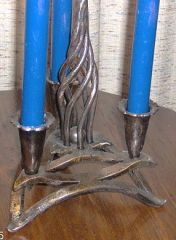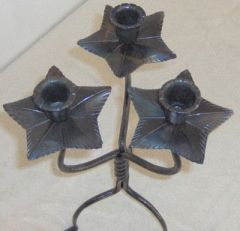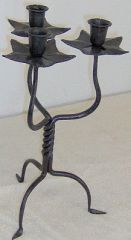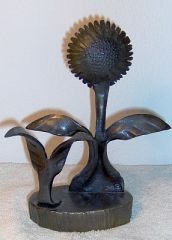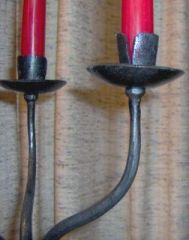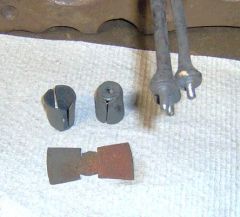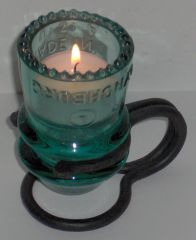
anvillain
Members-
Posts
134 -
Joined
-
Last visited
Content Type
Profiles
Forums
Articles
Gallery
Downloads
Events
Everything posted by anvillain
-
torture chamber candleholder The base is 3/8"plate,torch cut, forged,massaged with rotary file, heat tinted after cups and basket twist were welded or brazed on underside. The ball bearing imprisoned inside the cage would really prefer to be rolling around. The cups with integral drip flares were forged from 3/4" pipe.
-
-
-
funflower Why do blacksmiths like to make flowers out of iron? I have asked myself that, and someone else asked me, too. Well, its just an attempt to emulate other artists of old, maybe. Its fun, even if not pratical, so I named this the funflower since it vaguely resembles a sunflower which, of course, is much more useful.
-
bowtie candle cup, drip pan riveted This view shows one of the candlesticks using the forged shoulder. Not visible is a tenon forged on the end of the shoulder. It is riveted inside the cup by supporting the shouder in a split bolster block which held in a leg vise. There are three upright stems twisted together to form the main frame
-
candlestick tenons & bowtie cups In the foreground is a bowtie shaped pc of 14 ga steel, right behind it is two of them shaped and holes drilled, ready for riveting on the tenons at upper right. The drip pans which I also make of 14 ga circles from 3" to 4" are not shown here but can be seen assembled in the "two candlestick" photo. I like 14 ga although 16 ga is ok, but the riveting process doesn't distort the heavier ones so much.
-
two candlesticks I have made several variations of these two very different styles and methods. The one on the left is made of three 3/8" round HR. Underneath the drip pans is a forged shoulder and tenon. The tenon goes up thru both pan and cup and is riveted inside. The legs are twisted together to form the main body. The cups are made of my bowtie design . This one is all traditionally made. The one on the right is made using torch, grinder, arc welder but has forged cup and integral drip pan plus forge welded finial
-
I tried to make these as uniform as possible by hand and eye to look good on the same wall. The wall brackets are slightly more decorative than true colonial work, which was done with a minimum of material and labor. (my interpretation only). If you look real close you may see some imperfections, but if you close one eye and turn your head real quick they look ok. :-)
-
-
-
In case some may wonder why I use the name anvillain . I used to live by a small town called Plainville. It's residents were sometimes called plain-villains in jest. Actually they were some of the finest people on Earth. Well I don't live by my anvil as far as making a living goes, but a lot of my free time is spent thinking about forging and anvil related stuff. I enjoy making small ornamental forgings. I've had enough of the big heavy, hard work. :-)
-
Most Helpful Hint/Trick...
anvillain replied to primtechsmith's topic in Blacksmithing, General Discussion
ThomasPowers: I've noticed that Darwinian Interventions often follow a cranio-rectal inversion. :-) Anvillain -
Most Helpful Hint/Trick...
anvillain replied to primtechsmith's topic in Blacksmithing, General Discussion
To those who are new to blacksmithing: Start simple, and simply get started. With minimum of tools and with basic operations(as in the "Blacksmith Craft"). The iron will lead you on from there. Anvillain -
I'm in Western Illinois, I first tried some local coal from the August area, and it was plenty hot, but seemed to make a lot of stinky smoke, but that was before I had much experience at fire building. Since then I've used several ton of the Pocahontas coal from Indiana and I like it for the most part although like others have said it can be variable. I think there used to be a supplier in Pekin or East Peoria but I can't seem to locate the name and number. For myself, unless transportation costs come down I'm thinking of switching to LP gas (which also is transported, but more readily available than coal.) Actually there are quite a few members of the IVBA in your neck of the woods. I would join them, its only $15 per year and get to know some of the area craftsmen, they can give you better info than I can, since Western Illinois is like being in another state from you. Anvillain
-
English as she is spoke or writ
anvillain replied to Strine's topic in Blacksmithing, General Discussion
I was caused to remember another saying that was no doubt attributed to smithing: "A chain is no stronger than its weakest link." As I had an elderly log chain come apart between tractor and mulberry stump. Anvillain -
English as she is spoke or writ
anvillain replied to Strine's topic in Blacksmithing, General Discussion
I found an old grindstone in the dirt floor of my grandads old shed the other day. It was worn down to about 13" diameter. I guess a lot of neighbors that came by must have had an "axe to grind" Anvillain According to the "born loser" the future isn't what it used to be! -
Brucerdn Mr Wolridge answered perfectly in my opinion. Unless you try to pass off modern methods as traditional there is no reason to hold back. There is no forge weld as strong as an arc weld, assuming both are done by an expert. I have made a living using an arc welder,MIG, TIG, plasma, torch and all the wonderful tools that have evolved for metal-working. The blacksmiths embraced the new tools as soon as available to them because of their efficiency. The last 8 yrs I have been learning the old methods and use them for ornamental work. There are places where the traditional methods are even more efficient than the new. Plus the joy of that feeling of being connected to the smiths of thousands of years ago. Anvillain
-
English as she is spoke or writ
anvillain replied to Strine's topic in Blacksmithing, General Discussion
It just shows what a wonderful medium the English language is! I doubt that any other language has so many opportunities for humorously misconstruing what was originally said nor so many ways of saying the same thing. It can be so personalized that its almost as if each person has his own dialect. I have been "smitten" by the clever replies. Anvillain -
English as she is spoke or writ
anvillain replied to Strine's topic in Blacksmithing, General Discussion
This one may or may not have come from blacksmithing, so if it came from some other source I trust no one will get "all bent out of shape over it" :mrgreen: anvillain -
The design is great! But it has more than that, it has STYLE. I'll bet you would have a crowd following you before you get set up. Now if if you could add a popcorn popper attachment or maybe a coffee maker to the side.... Anvillain
-
how to get a long heat on a bar for scrolling
anvillain replied to Rick Barter's topic in Blacksmithing, General Discussion
I couldn't resist throwing in my two cents. All the answers above are right on, but IF one DID want to make a long heat, a long fire is a great asset. Fires (coal) can be made just about any size or shape you want,with the right planning and equipment. My forge, as I stand facing it, is wider than it is from front to rear. I also use notches on each end to accomodate long bars. after starting the fire I lay a trench of coke from a previous fire, then bank it on front and rear with wet coal, gradually giving it air it follows the coke faster than it will burn into the wet coal. To maintain it I sprinkle water on each side of the fire to help keep it from spreading. After several hours it will become unmannerly and spread out. I will pull back some of the excess and let it cool, then lay more fresh,wet coal on the sides of the trench and the coke I just pulled out will go over the center as needed. Another way is to lay firebrick to help keep it from spreading. In hot weather firebrick can also keep you from cooking your body :mrgreen: anvillain -
Things that make life easier
anvillain replied to Glenn's topic in Blacksmithing, General Discussion
Also large coffee cans make life easier. first they allow you to make lots of coffee which is the first thing I think of in the morning. After that one of the neatest uses I've found is for storing tubes of caulk. six of them will go arouond the outside and one in the middle. No more tumbling tubes of caulk. Your numbers may vary as the size of coffee cans shrink. They used to hold 3 lbs. of coffee :-). Coffee cans are probably the most universally used storage facility there is. -
Things that make life easier
anvillain replied to Glenn's topic in Blacksmithing, General Discussion
Ah! Let me count the ways! No, they are countless. But assuming one has a forge and anvil and vice already, an electric welder, an oxy-acetylene torch are nearly as important as anything can be for anyone afflicted with metal madness. I've had these for decades and couldn't imagine how handicapped I would be without them. Recently I added a nice Dewalt chopsaw. This is my favorite, the model with the handle in the horizontal position is way more comfortable than anything else on the market because it doesn't require you to bend your wrist. This I found out by using every brand available for many different contractors. And the wrist comfort is important if you are making scores of cuts per day, especially on heavy material that takes quite some force to push it down. Definitely don't forget BOTH safety glasses and a face shield. Or it could make life more difficult. Anvillain PS: I discovered recently that I am in a real metallic age. I have silver in my hair, gold in my teeth,copper in my pocket and lead in my uh-uhh -
I appreciated the previous posts on this subject and the experience represented in them. I have never been a firefighter but I have worked in nuclear power plants where in the reactor bldg you are going in many times without the normal cooling systems. Plus you will have protective clothing and possibly raingear and supplied air masks. Added to that most of it is claustrophobic in the lack of space. The best protection is a healthy body. Next you have to pace yourself so that you can avoid the overheating. Of course firefighters have much more urgency in their situations, but in non-emergency work you can have more time to pay attention to you body signals of overheating. I don't know if this is medically sound but if I feel that I'm approaching the danger point I will run cold water on my hands and wrists, then on my cheeks and forehead for a quick cool-down that has never given me any complications. If you are in bad health this may not be appropriate. Anvillain
-
new guy question about using gloves
anvillain replied to blacksmithtech's topic in Blacksmithing, General Discussion
This subject has been thoroughly covered, but my 2 cents worth is: Sometimes I use em and sometimes I don't. On light work mostly I don't, but you can always stand more heat with a glove on. Mainly I do what seems right at the time and if I use gloves I feel absolutely no guilt, nor do I concern myself if great-great grandpa would have done so. Anvillain
